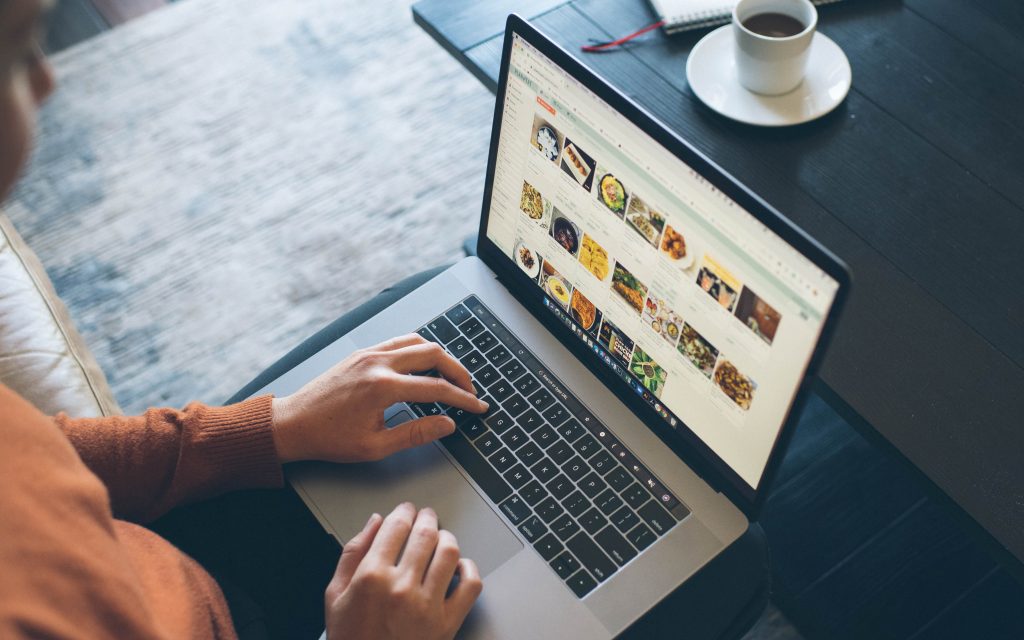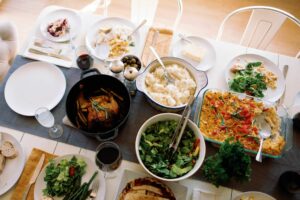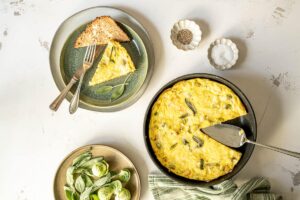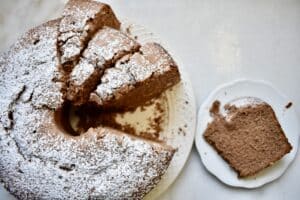While a pen-and-paper plan is helpful, I’m here to convince the pen-and-paper planners (or dry-erase and whiteboard planners) that digital planning is better…because it is better. To demonstrate, let’s see a pros and cons list for pen and paper planning:
Pros of pen and paper:
- Save money
- Waste less food
- Less stress about food and dinner plans
Cons of pen and paper:
- Takes a long time
- Disorganized shopping list
- Leave your list at home!
- Recipes from multiple sources (books, recipe cards, bookmarks, tabs on phone, Pinterest)
- Can only meal plan at home (where your recipes and calendar are)
- Always starting from scratch
- An incomplete shopping list, aka, did you write down everything you need?
Digital meal planning includes all of those pros but also solves all of the cons. I often get pushback from pen-and-paper planners on switching to a digital system, so let’s go through the list of cons and I’ll show you why digital deserves your attention.

Con #1. It takes a long time
Pen and paper planning is not a time saver. You have to find the recipes you want, create your meal plan, and handwrite a shopping list. Sorting through recipes and figuring out a plan can take a while, but transcribing a shopping list from recipes is a real time suck.
On the other hand, digital planning saves time because all the tools you need to create your meal plans live in one place. You have a digital recipe library, a planning calendar, and the program can make your shopping list for you.
People who create their meal plans digitally, spend 47.5% less time planning and shopping compared to people who use pen and paper.
Con #2. A disorganized shopping list
Whether you meal plan from specific recipes or from memory, it’s challenging to write a grocery list that’s properly organized. You might have milk next to oatmeal next to bananas and on and on. If you’re not constantly looking over your entire list while you shop, you’ll end up backtracking across the store to grab everything you need.
When a digital program creates a shopping list for you, it automatically sorts your items into proper categories, and some programs, like Plan to Eat, allow you to move those categories around to match the layout of your grocery store. You can make one trip around the store and save a ton of time shopping!
Con #3. Leaving your list at home
Before I started planning digitally, this was my biggest problem. I think I left my grocery list at home 50% of the time. Then I was left to try and remember what was on the list or what was on the meal plan, so I could try to remember the ingredients I needed. I usually ended up back at the store the next day to get all the things I forgot.
A digital system means you always have your shopping and meal plan on your phone. I rarely leave my house without my phone these days, so I always have my grocery list with me! This is also great because it means I can go to the store without specifically planning to, I can grocery shop after work, between errands, or whenever I’m out and about.
Con #4. Recipes everywhere
If you like to find recipes online, you probably have a hundred bookmarked recipes on your browser or ten tabs open on your phone, so you can find a recipe you liked and add it to your plan. Or maybe you have cookbooks, recipe cards, and magazine clippings. Perhaps you have half a dozen Pinterest boards filled with recipes. However you collect recipes, I’m certain it’s not organized or efficient.
With a digital system, you keep all your recipes in one place. It doesn’t matter where you find your recipes – blogs, Pinterest, recipe cards, cookbooks – they can all live together in a digital recipe library.
A curated recipe library is also great because you’re more likely to prepare the recipes you find online. When they’re all in one place you can search and find recipes that fit your mood, the season, a special occasion, or time spent cooking and quickly add them to your meal plan.

Con #5. Meal planning at home
It’s hard to pen and paper plan when you don’t have your recipes or calendar with you. This means you have to set aside time when you will be home to create your meal plan.
A digital system, where all the tools are at your fingertips, allows you to plan wherever you are! You can regain the lost time of sitting in the dentist’s office lobby, waiting in line to pick up your kids, or commuting on a train. If you have an extra 5 minutes, you can create a meal plan for the week.
Con #6. Starting from scratch
Pen and paper planning often means you’re planning the same meals over and over because you can’t come up with anything different. We don’t always start our meal plan with inspiration or great ideas of how to switch things up. It’s usually quicker to plan the same ole meatloaf or taco recipe you had last week.
I agree that done is better than perfect, but you don’t have to sacrifice variety for simplicity. A digital planner actually makes recipe variety easier because you’re not always starting your plan from scratch. Not only do you have an entire recipe library to look through and find inspiration, but you can also look back through past weeks (all of them) and see what you planned before that everyone liked. It relieves the mental load of coming up with new and interesting recipes by giving you built-in inspiration when you start to meal plan.
Con #7. An incomplete list
Just as a handwritten list is disorganized (see #2), it’s almost always incomplete. Our minds are fallible and we forget key ingredients for a recipe or random household items when creating a shopping list.
A digital list means the program takes the work out of remembering what you need for each recipe in your plan and allows you to add other household items as you realize you need them. You don’t have to find your piece of paper (or have three different pieces of paper) when you run out of something, you can simply open your phone and add the item to your list for your next shopping trip.
And you free up some mental space because you don’t have to keep a running tally of what you need in your head!
I truly believe any meal plan is better than no meal plan, but you can also make it easier on yourself by transitioning to a digital system that eases the common burdens of meal planning. Switching to digital can be tough, we love our pen and paper, but I promise it’s worth it!
Plan to Eat is the digital planner made for people who love pen-and-paper planning. You get to use your own recipes and curate your recipe library to meet your needs. You get to create meal plans that work for you, your schedule, and your dietary needs. And the program generates a shopping list for you that’s organized by both store and category. It’s all the things you love about pen and paper in a digital format!
Try Plan to Eat Free for 14 days and see if it works for you!






